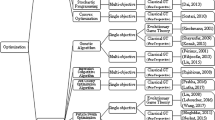Abstract
The aim of this paper is to propose the concept of the interval-valued least square prenucleolus of interval-valued cooperative games and develop a direct and an effective simplified method for solving a special subclass of interval-valued cooperative games. In this method, through adding some conditions, the least square prenucleolus of cooperative games is proved to be a monotonic and non-decreasing function of coalitions’ values. Hence, the interval-valued least square prenucleolus of coalition size monotonicity-like interval-valued cooperative games can directly obtained via determining its lower and upper bounds by using the lower and upper bounds of the interval-valued coalitions’ payoffs, respectively. Thus, the proposed method may overcome the issues resulted from the Moore’s interval subtraction and the partial subtraction operator. Examples are used to illustrate the proposed method and comparison analysis is conducted to show its applicability and superiority. Moreover, some important properties of the interval-valued least square prenucleolus of coalition size monotonicity-like interval-valued cooperative games are discussed.
Similar content being viewed by others
References
Alparslan Gök SZ, Branzei R, Tijs S (2009) Convex interval games. J Appl Math Decis Sci. doi:10.1155/2009/342089
Alparslan Gök SZ, Branzei R, Tijs S (2010) The interval Shapley value: an axiomatization. CEJOR 18:131–140
Alparslan Gök SZ, Branzei O, Branzei R, Tijs S (2011) Set-valued solution concepts using interval-type payoffs for interval games. J Math Econ 47:621–626
Bector CR, Chandra S (2005) Fuzzy mathematical programming and fuzzy matrix games. Springer, Berlin
Branzei R, Dimitrov D, Tijs S (2003) Shapley-like values for interval bankruptcy games. Econ Bull 3:1–8
Branzei R, Branzei O, Alparslan Gök SZ, Tijs S (2010) Cooperative interval games: a survey. CEJOR 18:397–411
Branzei R, Alparslan Gök SZ, Branzei O (2011) Cooperation games under interval uncertainty: on the convexity of the interval undominated cores. CEJOR 19:523–532
Driessen T (1988) Cooperation games: solutions and application. Kluwer Academic Publisher, Netherlands
Dubois D, Prade H (1980) Fuzzy sets and systems: theory and applications. Academic Press, New York
Han W-B, Sun H, Xu G-J (2012) A new approach of cooperative interval games: the interval core and Shapley value revisited. Oper Res Lett 40:462–468
Li D-F (2003) Fuzzy multiobjective Many–Person decision makings and games. National Defense Industry Press, Beijing
Li D-F (2011) Linear programming approach to solve interval-valued matrix games. Omega: Int J Manag Sci 39(6):655–666
Li D-F (2016) Models and methods of interval-valued cooperative games in economic management. Springer, Cham
Mallozzi L, Scalzo V, Tijs S (2011) Fuzzy interval cooperative games. Fuzzy Sets Syst 165:98–105
Mares M (2001) Fuzzy cooperative Games. Springer, Berlin
Moore R (1979) Methods and applications of interval analysis. SIAM Stud Appl Math, Philadelphia
Nishizaki I, Sakawa M (2001) Fuzzy and multiobjective games for conflict resolution. Springer, Berlin
Owen G (1982) Game theory, 2nd edn. Academic Press, New York
Ruiz LM, Valenciano F, Zarzuelo JM (1996) The least square prenucleolus and the least square nucleolus, two values for TU games based on the excess vector. Int J Game Theory 25:113–134
Schmeidler D (1969) The nucleolus of a characteristic function game. SIAM J Appl Math 17:1163–1170
Shapley LS (1953) A value for n-person games. In: Kuhn A, Tucker A (eds) Contributions to the theory of games II. Annals of mathematical studies. Princeton University Press, Princeton, pp 307–317
von Neumann J, Morgenstern O (1944) Theory of games and economic behavior. Princeton University Press, Princeton
Yager RR (2004) OWA aggregation over a continuous interval argument with applications to decision making. IEEE Trans Syst Man Cybern B Cybern 34(5):1952–1963
Acknowledgments
This research was sponsored by the Key Program of the National Natural Science Foundation of China (No. 71231003), the National Natural Science Foundation of China (Nos. 71171055, 71461005, and 71561008), and the Social Science Planning Project of Fujian Province (No. 2013B053).
Author information
Authors and Affiliations
Corresponding author
Rights and permissions
About this article
Cite this article
Li, DF., Ye, YF. Interval-valued least square prenucleolus of interval-valued cooperative games and a simplified method. Oper Res Int J 18, 205–220 (2018). https://doi.org/10.1007/s12351-016-0260-y
Received:
Revised:
Accepted:
Published:
Issue Date:
DOI: https://doi.org/10.1007/s12351-016-0260-y




